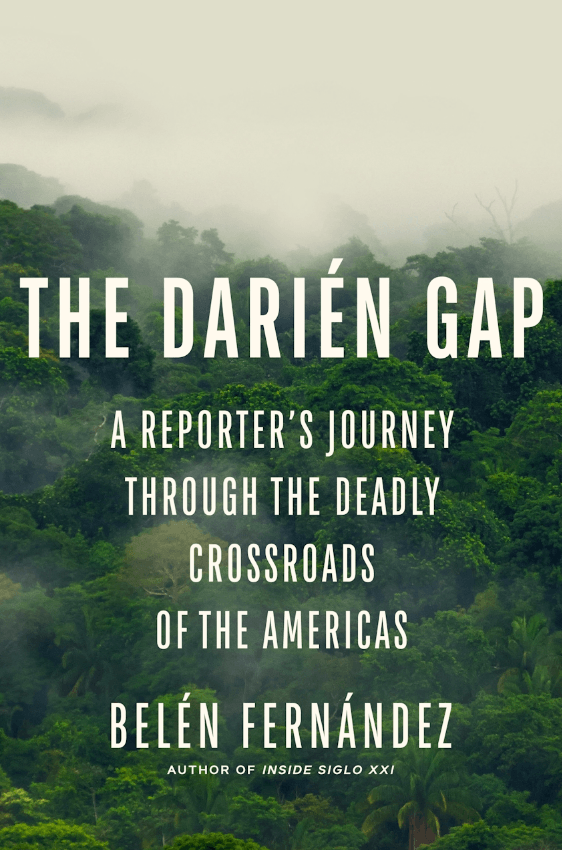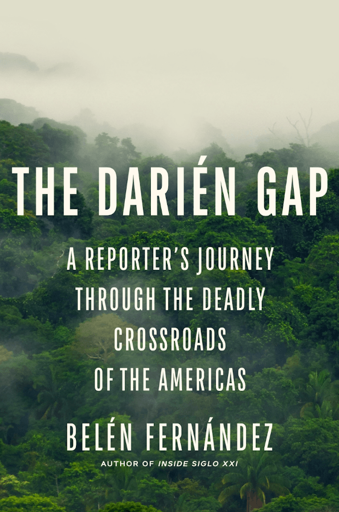The Darien Gap on the border of Colombia and Panama is the only stretch of the Pan-American Highway that is not a highway. Instead, it is a dangerous area of jungle filled with swamps, wildlife and rivers. It is also a major part one of the world’s migration routes. This means that the area is made extra dangerous due to criminal gangs, traffickers and other human predators populate and profit from those who traverse it. A late friend of mine used to hitchhike and hustle rides from California to Brazil every winter in the late 1970s and 1980s. When he talked about his journeys, he always mentioned this stretch of land as the one place he would take a boat; sometimes he had the money to pay for a spot and other times he would convince a boat captain to hire him on for a week or two as long as was able to get to the other side of the Darien Gap. Needless to say, his tales told of adventures well outside middle America’s experience and comfort zone.
Journalist Belén Fernández’s new book, *The Darién Gap: A Reporter’s Journey through the Deadly Crossroads of the Americas,*is also a tale of adventures well outside of middle America’s experience and comfort zone. It’s also a critique of the role US capitalism plays in maintaining, exploiting and intensifying migration from South America to its neighboring continent to the north. Indeed, Fernández’s reportage makes it quite clear that the main reasons people risk their lives and the lives of their children to migrate to the United States are cartel violence, government repression and poverty, not necessarily in that order. Despite the proclamations of anti-immigrant forces in the United States—from the White House to Congress to local police forces and residents of the communities they serve—virtually nobody takes this path for a lark or to steal someone else’s job. 
Fernández clarifies this at the beginning of her text when she quotes a Cuban woman she was in Siglo XXI prison with in Mexico: “Cubans,” she writes. “say no one leaves their country and walks through the selva for a week if they don’t have to.”(4) The selva in this instance is, of course, the rainforest jungle in which the Darien Gap lies. As she tells the story within these pages, the author also provides historical background, political analysis of the anti-imperialist kind, all the while detailing the travels of a group of Venezuelan men she has befriended, the ups and downs of her own quests and discussions with various migrants, law enforcement types and locals. The reader is introduced to families hanging on to their dignity in the face of heartless indifference, legal interference, fear and violence. Gangs run by cartels and local individuals extort, rob and rape while the state and private individuals try to profit from every potential exchange between a migrant and themselves. It’s not that the officials and the merchants harbor the same mentality as the killers and rapists, they just see an opportunity to make a few dollars. Nonetheless, Fernández tells the reader, the migrant journey through the Gap is something like a scene from a horror movie: corpses litter the route, dangerous animals from insects on up are a constant, the rivers are unpredictable making for difficult crossing and the terrain is challenging, to say the least.
It’s not all doom and gloom in these pages. A constant in these pages that defies the general atmosphere of tragedy and hopelessness is a certain type of romance she finds herself in. Johann, one of the seven young Venezuelan men the reader meets at the book’s beginning, catches her eye. The interest is returned and it is somewhere between the time the seven first meet and the two respond to their mutual interest that Fernández makes it her project to get the men into the United States. This task is not a simple one and involves numerous setbacks and hopes dashed, while also providing the narrative with a connecting thread injected with a certain hope and delight that love brings no matter what the circumstances.
As noted above, although politics are rarely mentioned in the text, they underline and inform the entire story. When they are mentioned it is usually Fernández who brings them up, often in terms of Washington’s imperial policies being the foremost reason there’s a massive migration even taking place. For example, US sanctions against Venezuela are the primary reason the Venezuelan economy struggles and why so many of that nation’s residents risk almost everything to go north. Despite Washington’s knowledge of this fact, it rejects any attempts to remove any of them. Haiti suffers directly from Washington’s ceaseless interference, supporting thugs and armed gangs to enforce the starvation wages US corporations pay Haitians who can find work. A similar scenario exists in Honduras, where Washington seems to move governments in and out of power at whim. The actual nature of US economic and political power in the world kills many, many more humans than all of the drug and human trafficking done by the cartels might ever do. Meanwhile, the cartels make deals with US agencies in the name of security or some such thing that both benefit from.
Belén Fernández’s The Darien Gap is a work that is timely, disturbing and engaging. Her seamless integration of personal stories (hers and those she meets), history, politics and economics makes for a captivating read. If one wished to read only one book on the issues of the current migration to the United States, The Darien Gap should be among the shortlist of those books they considered.
The post Surviving the Selva: The Darien Gap and Migration appeared first on CounterPunch.org.
From CounterPunch.org via this RSS feed


